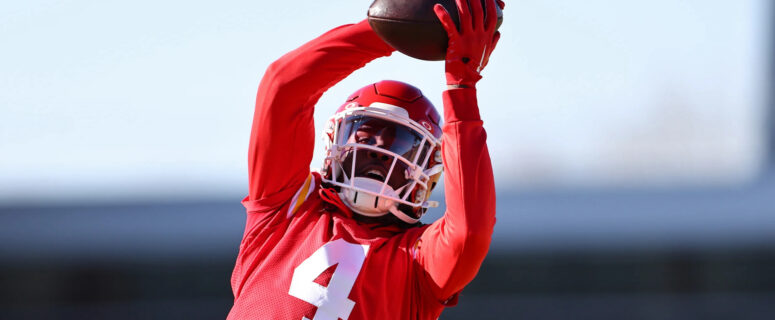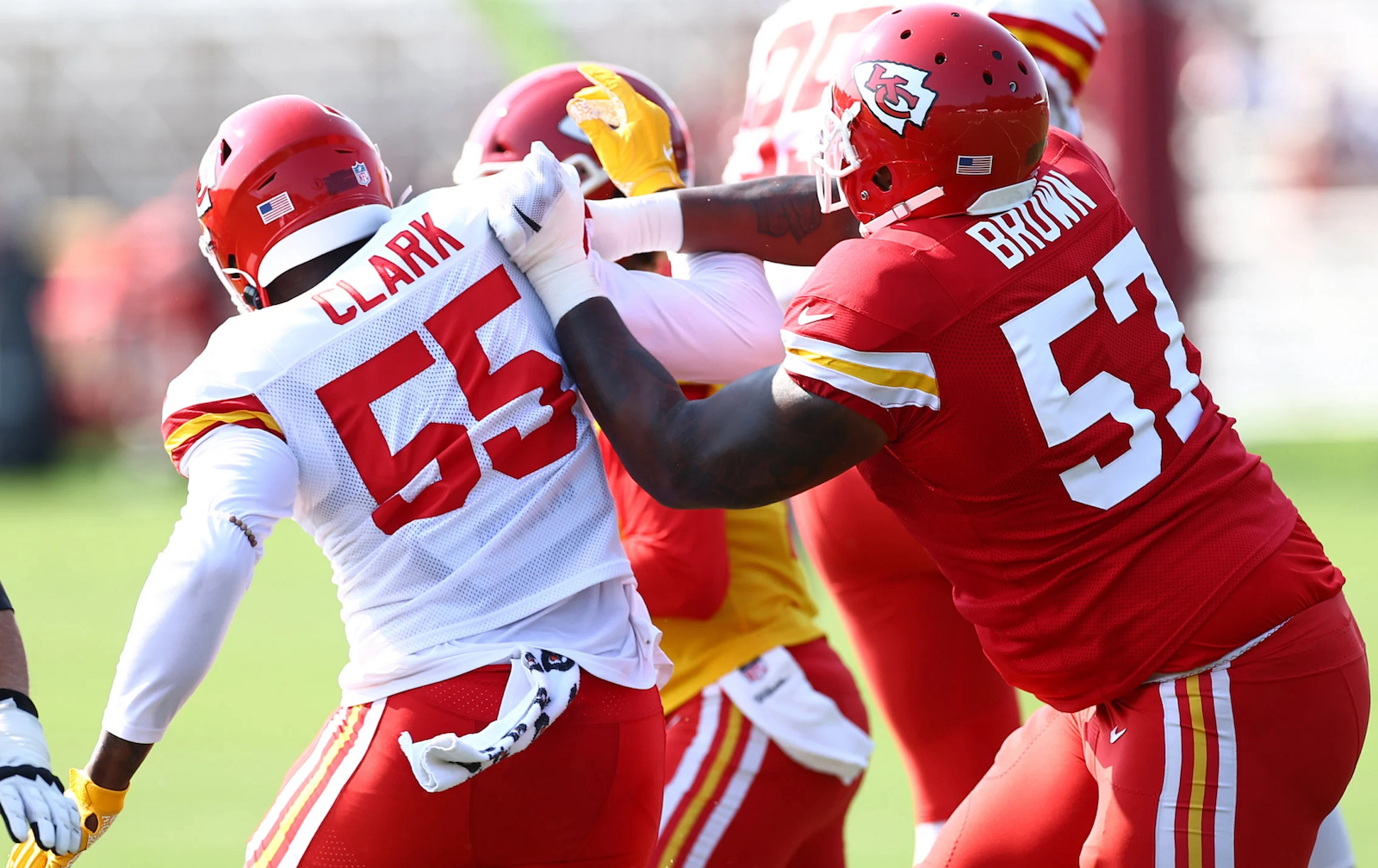KANSAS CITY, Mo. — The Chiefs host the Philadelphia Eagles Monday night, opening up the second half of their season following the bye week. Kansas City stands 7-2 and holds the pole position in the race for the No. 1 seed in the AFC.
If the Chiefs want to bid for a second-straight Super Bowl title, they need more production from a handful of players. Here are four bold takes on performances from key Chiefs that can drive a strong second half of the season.
Bold Take: Rashee Rice Will Pass DeSean Jackson Rookie Mark
Since 1999, 17 rookies have eclipsed 1,000 yards, and another eight have reached 950 yards. They all have one thing in common — none played for Andy Reid, who has been one of the league’s most prolific offensive minds of the last quarter century.
The rookie record for receiving yards under Reid belongs to DeSean Jackson, who posted 912 yards during this rookie season in 2008. Tyreek Hill’s 593 yards in 2016 is the high watermark for a rookie during the Reid era in Kansas City.
Rookie Receiving Yards Under Andy Reid
| Player | Targets | Receptions | Yards | Yards per Catch | TD |
| DeSean Jackson | 120 | 62 | 912 | 14.7 | 2 |
| Jeremy Maclin | 91 | 56 | 773 | 13.8 | 4 |
| Tyreek Hill | 83 | 61 | 593 | 9.7 | 6 |
| Reggie Brown | 79 | 43 | 571 | 13.3 | 4 |
| Mecole Hardman | 41 | 26 | 538 | 20.7 | 6 |
| Hank Baskett | 42 | 22 | 464 | 21.1 | 2 |
| Kareem Hunt | 63 | 53 | 455 | 8.6 | 3 |
| Rashee Rice (through nine games) |
41 | 32 | 378 | 11.8 | 4 |
Rashee Rice is already claiming the rookie receiving chart under Reid, ranking No. 8 with just nine games under his belt. Based on his performance through Week 10, Rice is on pace for 60 catches, 714 yards and eight touchdowns. His 378 yards receiving are the most by a rookie through nine games under Reid in Kansas City — Mecole Hardman had 374 yards through the first nine games of 2019, while Kareem Hunt had 331 in 2017 and Tyreek Hill 323 in 2016.
Only two rookies with Reid in Philadelphia had more receiving yards through their first nine games than Rice: Jackson (586) and Jeremy Maclin with 413 yards in 2009.
To catch Jackson’s total of 912 yards, Rice needs 534 yards receiving in the second half, an average of 66.8 yards per game. Stretching to the 1,000-yard barrier would require 622 yards over the final eight games or an average of 77.8 yards per game.
There are reasons to believe Rice can make it to those lofty levels. While he leads the Chiefs with five drops, his catch percentage of 78% is the best for any Reid rookie receiver with at least 100 yards. Hill had a 73.5% catch rate while Maclin (61.5%) and Jackson (51.7%) were even lower.
His success rate — gaining at least 40% of the necessary yards for a first down on first down, 60% on second down and 100% on third and fourth down — of 58.5% is third-best for a receiver under Reid. Also in Rice’s favor is his ability to get into the end zone. The six touchdowns by Hardman rank best for a Reid rookie, and Rice is already on pace to break that mark.
Rice has shown steady improvement throughout the season. During a three-game stretch against the Broncos, Chargers and Broncos again, Rice averaged 62.7 yards per game. He’s going to see more playing time in the second half, and that should lead to more targets. It’s a tough uphill climb, but Rice should get the opportunities he needs to catch Jackson’s totals.
Bold Take: Isiah Pacheco Becomes 1,200-Yard Back
Isiah Pacheco entered the bye week with 525 yards on the ground, which puts him on pace for 992 yards on the season. But if the Chiefs hope to jumpstart the offense in the second half, one of the biggest keys is Pacheco.
This season’s small sample size illustrates the importance of Pacheco toward a well-rounded Chiefs offense. In the team’s seven wins, Pacheco averaged 15 carries for 66 yards. In the two losses, the running back tallied just eight carries for 32 yards.
It’s not a simple case of the Chiefs running the ball with the lead late in the game to run out the clock. Defenses are consistently playing soft, deep zones to take away the long ball from Mahomes and force the Chiefs to throw the football underneath. At times, defenses are daring to the Chiefs to run the football with extra defensive backs on the field and light boxes. Running the ball efficiently forces defenses to honor the run and makes the run-pass-option and play action more effective. A strong running game can force defenses into less zone coverage and closer to the line of scrimmage, opening up more opportunities for separation by the wide receivers.
Pacheco would need to average just more than 84 yards per game to reach 1,200 yards on the season. Based on his current average of 4.2 yards per carry, he would need 20 touches per game to get there. If he’s able to get closer to his rookie average of 4.9 yards, he would need just 17 carries per game.
It’s not necessarily that Pacheco can get to 1,200 yards but more that if he does pull off this feat it’s a prime indication that the Chiefs offense has returned to peak performance.
Bold Take: Three Chiefs Will Tally 10 or More Sacks
It’s not a super bold take to say three Chiefs will reach double-digit sacks since three players are already on pace for that feat. George Karlaftis leads the team with six sacks while Chris Jones and Mike Danna have five and a half, putting them right on the edge of pacing for 10 sacks.
It’s more about how rare a feat that is. Since sacks became an official statistic in 1982, only 22 teams have pulled off that feat — and it’s only happened four times so far this century. Only one team, last year’s Philadelphia Eagles, had four players with double-digit sacks (Brandon Graham, Javon Hargrave, Haason Reddick and Josh Sweat). The last team with three double-digit sacks performers was the 2014 Bills with Marcell Dareus, Jerry Hughes and Mario Williams.
The Chiefs have never had three players with 10 or more sacks in a season. Two players have achieved that mark in the last 40 years, most recently in 2018 with Chris Jones and Dee Ford. Derrick Thomas and Neil Smith did it twice (1992 and 1994) while Justin Houston and Tamba Hali combined in 2013 and Art Still and Mike Bell achieved it in 1984.
The Chiefs defense remains prolific and gets to the quarterback, ranking second in the league behind Baltimore in sacks per game and second behind Cleveland in sack percentage on dropbacks. The biggest obstacle might be that coordinator Steve Spagnuolo is an equal-opportunity blitzer, as evidenced by the 13 different players who have at least a half-sack. Karlaftis, Jones and Danna may have to share the wealth. But no doubt the Kansas City defense can get to the quarterback and that trio are having special seasons.
Bold Take: Chiefs Offense Will Average 27 Points Per Game
Perhaps the most surprising development of the 2023 season is the Kansas City offense ranking 14th in the league in scoring with just 23.1 points per game. It helps that the defense has allowed just 15.9 points per contest, ranking second-best in the league behind San Francisco (15.7).
But a lack of efficiency loomed as a huge problem for the Chiefs offense in the first half of the season. The team has the fourth-highest turnover rate in the league, coughing up the ball on 16% of drives (compared to just 10.1% last season). The Chiefs ranked first in the league last season on yards and points per drive, but have fallen to seventh and ninth respectively this season.
Discipline has also been a problem for the offense, which is on pace for 70 penalties this season after getting flagged just 43 times last season. Add in 25 drops by receivers and other pass catchers, and at times the Chiefs offense’s biggest enemy has been itself.
The Chiefs averaged 29.2 points per game in 2022 while leading the NFL in scoring. Getting the average back to that level by the end of the season is probably unrealistic, and if the defense continues to play lights out there won’t be a need for big scoring outputs. But finishing the season averaging 25 points per game is possible if the Mahomes and company can score at least 27 points per contest in their final eight games.
How can the Chiefs do that? Reduce turnovers (17), penalties and drops by 30%. Difficult? Yes. Impossible? No. In fact, those numbers would still be worse than the Chiefs offense performed last season. But those three improvements alone should result in at least on more scoring drive per game and help the Chiefs add four points to their average in the second half.


